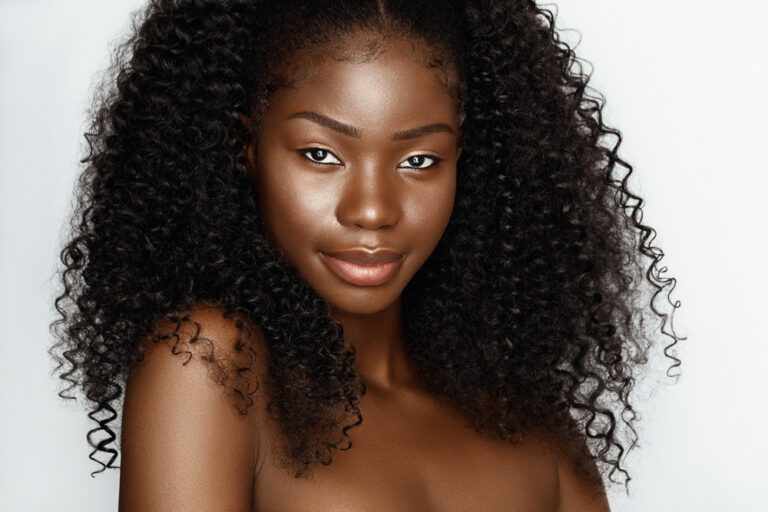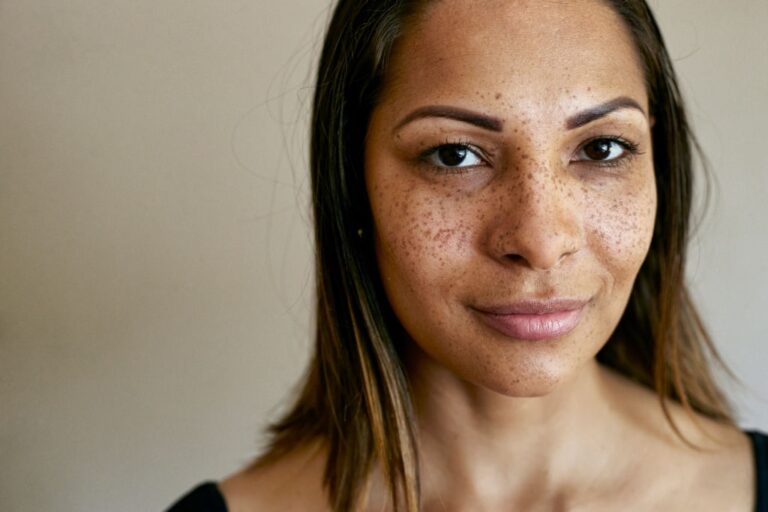here are four essential components to maintaining healthy brown skin:
- Knowledge
- Self-examination
- Protection
- Nurturing
Once you understand the essential components for healthy skin, you will be well equipped to take care of your skin.
Knowledge
The first step to good skin health is being knowledgeable about your brown skin. We clearly know that the melanin in brown skin distinguishes it from the skin of others. There are several other distinctive but normal characteristics that may be present in women with brown skin. These include:
- Futcher’s Lines – Lines on the upper arms that separate lighter skin on the inside of the arm from the darker skin on the outside
- Mid-line Hypopigmentation – Skin on the middle of the chest that is lighter in tone than the skin toward the sides of the chest
- Palmar Crease Hyperpigmentation – Creases in the palms that are darker than the skin on the remainder of the palms
- Hyperpigmented Kerototic Palmer Pitting – Small pinpoint holes in the palms with a dark core
- Pigmented Nail Streaks – Dark brown streaks running from the cuticle to the end of the nails. If, however, you have a streak on only one nail, it could be a sign of cancer that must be evaluated by a dermatologist.
- Gingival Hyperpigmentation – Darkened gums around your teeth
Self-Examination
The second step to good brown skin health is regular skin self-examination. In general, brown skin is less susceptible to skin cancer, but when it does strike, it is often more deadly than in other skin types. Women of color (and men) must first be aware that they are indeed at risk for skin cancer and that early detection is important. Once every month, your skin must be examined from head to toe, paying particular attention to your hands, fingers, feet, toes, nails, and mouth, where melanoma-type skin cancers are more likely to appear in people of color. Look for dark brown or black spots in these areas no matter how small. Pay particular attention to new spots or spots that change. The change can be an increase in size, shape, or color or a raised bump that develops within the spot. A bump on the foot or toe that is sore or does not heal is another tip-off for skin cancer. Be on the lookout for dark streaks or lines along with one fingernail or toenail only. If you find anything unusual, any area that you think might have changed or any particularly dark or irregular spot, see your dermatologist right away.
The National Cancer Institute recommends these steps for checking your skin for signs of cancer. After a bath or shower, use a full-length or hand-held mirror to check all areas—including your hands, feet, nails, back, scalp, buttocks, and genitals.
- Look at the front and back of your body in the mirror, then raise your arms and look at the left and right sides.
- Bend your elbows and look carefully at your palms, your forearms, including the undersides, and your upper arms.
- Examine the back and front of your legs. Also, look between the buttocks and around the genital area.
- Sit and closely examine your feet, including the soles and the spaces between the toes.
- Look at your face, neck, and scalp. You may want to use a comb to move hair so that you can see better.
Protection
The third step in ensuring healthy brown skin is protected from the sun. Though the average woman with brown skin has a natural SPF of 13 (which means you can stay in the sun without burning 13 times longer than a woman with white skin), we still need to include sunscreen in our daily skincare routine for healthy skin. Sunscreens work by absorbing the harmful ultraviolet A (UVA) and ultraviolet B (UVB) rays before they can affect the skin. Sunblocks create a protective barrier that reflects UV rays, causing them to bounce off the skin. For most women of color, a sunscreen with an SPF 15 (which means you can stay in the sun 15 times longer without burning) is sufficient, but if you have certain medical conditions, such as lupus, or take certain medications, or have dark marks or skin discolorations, you may need a sunscreen with an SPF 30. Look for broad-spectrum products containing ingredients that protect the skin from both UVA and UVB rays.
Sunscreen Tips
- All women with brown skin should use sunscreen daily
- Always apply sunscreen 20 minutes before you’re exposed to the sun to allow your skin to absorb the product and create a protective shield.
- Use sunscreen generously on all exposed skin—face, neck, and hands. Apply at least a shot-glass full (about one ounce).
- Store sunscreen away from the sun and heat to prevent spoiling.
- Reapply it after vigorous exercise or swimming even if the product is labeled “waterproof”.
- Take note of expiration dates. If a bottle does not have an expiration date, toss it after one year.
- Sunscreen in foundation wears off after only a couple of hours so it’s best to apply sunscreen separately, under makeup, or in moisturizers that say SPF 15 on the label.
- Sunscreen formulations include creams, lotions, sprays, gels, roll-ons, and moisturizers. Find a product that meets your personal preference.
Nurturing
The final step to care for healthy brown skin is to nurture your skin. It is important to avoid irritants that may stimulate the production of excessive melanin. Ingredients in soaps, cleansers, toners, moisturizers, astringents, anti-aging products, and anti-acne agents to name just a few, are possible irritants. The following is a list of potential irritants to avoid:
- Cleansers, toners or astringents containing alcohol, propylene glycol, fragrance, or dyes
- Products containing essential oils (concentrated oil extracts from plants)
- Moisturizers containing fragrance, lanolin, dye, alcohol or propylene glycol
- Sunscreens containing fragrance, oil, PABA
- Makeups containing oil
- Alpha-hydroxy acid in high concentrations or at certain pHs
- Detergents and fabric softeners containing fragrance, dyes, or preservatives
Now that you are aware of ingredients to avoid in maintaining your brown skin, you can concentrate on proper cleansing techniques. Many women with brown skin make the mistake of over-cleaning—cleaning the face, neck, elbows, and knees too often or too roughly. But most skincare problems (acne, dark marks, clogged pores) are not caused by dirt, so there’s no need to use either harsh products or rough cleansing techniques. The following cleansing clues will guide you.
Tips on Better Cleansing
- Cleanse your face daily to remove dirt, oil, and makeup
- Avoid abrasive cleansers or cleansing products (puffs, loofahs), which can irritate brown skin
- Cleanse facial skin with your fingertips and massage gently in a circular motion
- Use products designed for your skin type: oily, dry, normal, combination, sensitive, acne-prone or hyperpigmenting
- Exfoliate if you need to remove dull, dead skin cells by using gentle exfoliating acids found in skin products—but test the product on a small patch of skin first or check with your dermatologist.
Bottom Line
Finally, to properly care for brown skin requires knowledge of its unique structure and properties. Monthly self-examinations and protection from the sun are essential for the health of this skin type. Avoidance of products that irritate brown skin, and lead to dark marks, is essential.




